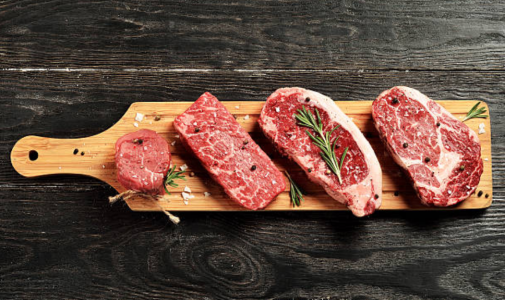New premium meat hits markets with record price tag
By
Gian T
- Replies 0
A groundbreaking innovation in the food world has captured the attention of chefs and food lovers alike.
Producers have unveiled a new premium product that boasts a level of quality never seen before.
With its luxurious price tag and unique features, it’s quickly becoming the talk of the culinary scene.
The star of the show is the KS7 Hampshire Down lamb, developed by a team of passionate Aussies at Kinross Station, Endeavour Meats, and Meat and Livestock Australia.
What sets this lamb apart? It’s all about the marbling. While your average Aussie lamb has about 4 per cent intramuscular fat (that’s the tasty stuff that makes meat juicy and tender), the KS7 boasts a whopping 7 per cent.
For context, that’s nearly double the marbling of most lambs here, and even more than what you’ll find in Europe or New Zealand.
But what does all that marbling mean for your taste buds? According to Tom Bull, the innovative farmer behind Kinross Station, it’s a game-changer. '
A lot of people don’t like that strong lamb taste, but the Hampshire Down lamb is really subtle and more of a beef texture,' he explained.
So, if you’ve ever found lamb a bit too ‘lamby’, this could be the dish that changes your mind.
At over $100 a kilo, this isn’t your everyday Sunday roast. But before you clutch your pearls, consider this: the rich marbling means you’ll eat less of it in one sitting.
'The higher the marbling, the less you eat. If you get a really good piece of Wagyu, you don’t want to eat an 800-gram steak, because you’ll feel quite sick,' Bull said.
The same goes for this lamb—two ribs are all you need for a decadent meal, rather than the usual four.
The price also reflects the years of careful breeding and feeding that go into producing each animal.
The KS7 lambs are the result of four to five generations of selective breeding, focusing on 'outlier' rams with exceptional marbling.
Once selected, these lambs are raised in paddocks and fed a special diet of barley and lupin to enhance their flavour and texture.
If you’re keen to try this marbled marvel, you’ll need to book a table at Matt Moran’s Chophouse in Sydney, where it’s making its exclusive debut from mid-September.
Over time, the KS7 will appear at other high-end restaurants and select specialty retailers, but don’t expect to see it in your local Woolies or Coles anytime soon.
The focus, for now, is on export markets like Japan and the United States, where diners are already familiar with the rich, buttery taste of grain-fed beef.
There’s even interest from the Middle East, proving that Aussie innovation is making waves around the globe.
For the farmers, this breakthrough isn’t just about prestige—it’s about profit. With up to 60 per cent of some flocks meeting the seven per cent marbling standard, producers can earn an extra dollar per kilo, or about $35 more per head.
In an industry where margins can be razor-thin, that’s a significant boost.
This marbled lamb is just one example of how Australia is leading the way in premium meat production.
With the rise of lab-grown meats and alternative proteins, the industry is changing fast.
While some are wary of these new technologies, others see them as inevitable—and perhaps even necessary—as the world’s appetite for meat continues to grow.
For now, the KS7 is a rare treat reserved for fine dining and specialty butchers. But as demand grows and production scales up, who knows? Maybe one day, marbled lamb will be as common as a snag on the barbie.
 Have you ever tried Wagyu beef, and would you be keen to see the same quality in Aussie lamb? Or do you prefer your lamb the traditional way, with a bit of mint sauce and a side of roast potatoes? Let us know in the comments below.
Have you ever tried Wagyu beef, and would you be keen to see the same quality in Aussie lamb? Or do you prefer your lamb the traditional way, with a bit of mint sauce and a side of roast potatoes? Let us know in the comments below.
Read more: You won’t believe how this Aussie mum made a delicious meal with just 4 ingredients—and one costs only $1.20!
Producers have unveiled a new premium product that boasts a level of quality never seen before.
With its luxurious price tag and unique features, it’s quickly becoming the talk of the culinary scene.
The star of the show is the KS7 Hampshire Down lamb, developed by a team of passionate Aussies at Kinross Station, Endeavour Meats, and Meat and Livestock Australia.
What sets this lamb apart? It’s all about the marbling. While your average Aussie lamb has about 4 per cent intramuscular fat (that’s the tasty stuff that makes meat juicy and tender), the KS7 boasts a whopping 7 per cent.
For context, that’s nearly double the marbling of most lambs here, and even more than what you’ll find in Europe or New Zealand.
But what does all that marbling mean for your taste buds? According to Tom Bull, the innovative farmer behind Kinross Station, it’s a game-changer. '
A lot of people don’t like that strong lamb taste, but the Hampshire Down lamb is really subtle and more of a beef texture,' he explained.
So, if you’ve ever found lamb a bit too ‘lamby’, this could be the dish that changes your mind.
At over $100 a kilo, this isn’t your everyday Sunday roast. But before you clutch your pearls, consider this: the rich marbling means you’ll eat less of it in one sitting.
'The higher the marbling, the less you eat. If you get a really good piece of Wagyu, you don’t want to eat an 800-gram steak, because you’ll feel quite sick,' Bull said.
The same goes for this lamb—two ribs are all you need for a decadent meal, rather than the usual four.
The price also reflects the years of careful breeding and feeding that go into producing each animal.
The KS7 lambs are the result of four to five generations of selective breeding, focusing on 'outlier' rams with exceptional marbling.
Once selected, these lambs are raised in paddocks and fed a special diet of barley and lupin to enhance their flavour and texture.
If you’re keen to try this marbled marvel, you’ll need to book a table at Matt Moran’s Chophouse in Sydney, where it’s making its exclusive debut from mid-September.
Over time, the KS7 will appear at other high-end restaurants and select specialty retailers, but don’t expect to see it in your local Woolies or Coles anytime soon.
The focus, for now, is on export markets like Japan and the United States, where diners are already familiar with the rich, buttery taste of grain-fed beef.
There’s even interest from the Middle East, proving that Aussie innovation is making waves around the globe.
For the farmers, this breakthrough isn’t just about prestige—it’s about profit. With up to 60 per cent of some flocks meeting the seven per cent marbling standard, producers can earn an extra dollar per kilo, or about $35 more per head.
In an industry where margins can be razor-thin, that’s a significant boost.
This marbled lamb is just one example of how Australia is leading the way in premium meat production.
With the rise of lab-grown meats and alternative proteins, the industry is changing fast.
While some are wary of these new technologies, others see them as inevitable—and perhaps even necessary—as the world’s appetite for meat continues to grow.
For now, the KS7 is a rare treat reserved for fine dining and specialty butchers. But as demand grows and production scales up, who knows? Maybe one day, marbled lamb will be as common as a snag on the barbie.
Key Takeaways
- Australian farmers have created a world-first marbled lamb, similar to high-end Japanese Wagyu, with a price tag of more than $100 a kilo—about double the usual price of lamb cutlets at major supermarkets.
- The newly bred KS7 Hampshire down lamb boasts seven per cent intramuscular fat, compared to the Australian average of four per cent, resulting in a richer, more subtle flavour and a texture closer to beef.
- Due to its richness, diners are expected to eat smaller portions of the marbled lamb, and the product is aimed at export markets like Japan and the US, as well as high-end Australian restaurants.
- KS7 marbled lamb will initially be available exclusively at Matt Moran’s Chophouse in Sydney and later at other select restaurants and premium retailers, but is unlikely to ever appear in regular supermarkets.
Read more: You won’t believe how this Aussie mum made a delicious meal with just 4 ingredients—and one costs only $1.20!








